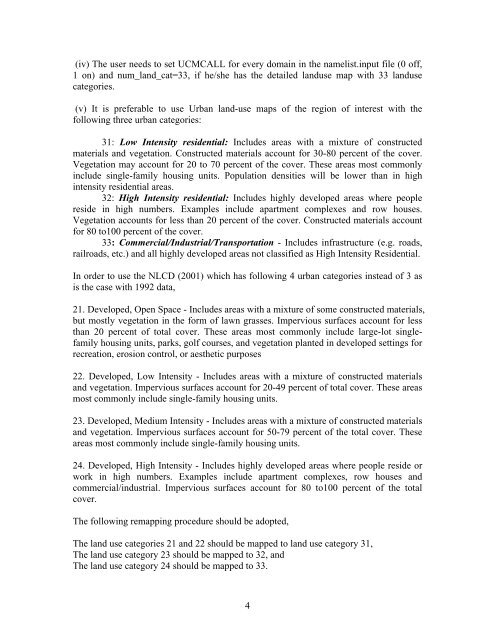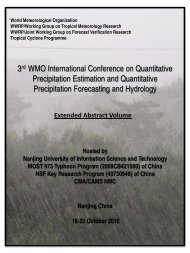Coupled WRF/Unified Noah LSM
Coupled WRF/Unified Noah LSM
Coupled WRF/Unified Noah LSM
Create successful ePaper yourself
Turn your PDF publications into a flip-book with our unique Google optimized e-Paper software.
(iv) The user needs to set UCMCALL for every domain in the namelist.input file (0 off,<br />
1 on) and num_land_cat=33, if he/she has the detailed landuse map with 33 landuse<br />
categories.<br />
(v) It is preferable to use Urban land-use maps of the region of interest with the<br />
following three urban categories:<br />
31: Low Intensity residential: Includes areas with a mixture of constructed<br />
materials and vegetation. Constructed materials account for 30-80 percent of the cover.<br />
Vegetation may account for 20 to 70 percent of the cover. These areas most commonly<br />
include single-family housing units. Population densities will be lower than in high<br />
intensity residential areas.<br />
32: High Intensity residential: Includes highly developed areas where people<br />
reside in high numbers. Examples include apartment complexes and row houses.<br />
Vegetation accounts for less than 20 percent of the cover. Constructed materials account<br />
for 80 to100 percent of the cover.<br />
33: Commercial/Industrial/Transportation - Includes infrastructure (e.g. roads,<br />
railroads, etc.) and all highly developed areas not classified as High Intensity Residential.<br />
In order to use the NLCD (2001) which has following 4 urban categories instead of 3 as<br />
is the case with 1992 data,<br />
21. Developed, Open Space - Includes areas with a mixture of some constructed materials,<br />
but mostly vegetation in the form of lawn grasses. Impervious surfaces account for less<br />
than 20 percent of total cover. These areas most commonly include large-lot singlefamily<br />
housing units, parks, golf courses, and vegetation planted in developed settings for<br />
recreation, erosion control, or aesthetic purposes<br />
22. Developed, Low Intensity - Includes areas with a mixture of constructed materials<br />
and vegetation. Impervious surfaces account for 20-49 percent of total cover. These areas<br />
most commonly include single-family housing units.<br />
23. Developed, Medium Intensity - Includes areas with a mixture of constructed materials<br />
and vegetation. Impervious surfaces account for 50-79 percent of the total cover. These<br />
areas most commonly include single-family housing units.<br />
24. Developed, High Intensity - Includes highly developed areas where people reside or<br />
work in high numbers. Examples include apartment complexes, row houses and<br />
commercial/industrial. Impervious surfaces account for 80 to100 percent of the total<br />
cover.<br />
The following remapping procedure should be adopted,<br />
The land use categories 21 and 22 should be mapped to land use category 31,<br />
The land use category 23 should be mapped to 32, and<br />
The land use category 24 should be mapped to 33.<br />
4














